With the summers being so intense and lasting interminably longer these days, future urban centres may just have to be planned underground.
Suggest that to anyone from Cappadocia in Central Anatolia, Turkey and he or she is bound to grin from ear to ear – their region could very well be the underground capital of the world. There are supposedly hundreds of subterranean cities in Cappadocia, with an estimated 40 identified and seven open to visitors.
Researchers have been able to date these architectural marvels to as far back as the Hittites, Cappadocia’s early settlers. In the 1960s, German scientist Martin Urban studied them extensively, concluding that some of the cities could have been built in the 7th and 8th centuries BC.
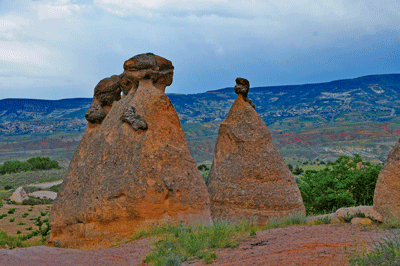
But it is Xenophon, a journalist from a much earlier era (430-355 BC), who pictured them in colourful detail in his book Anabasis: “…The houses in the villages were constructed under the ground. The entrances to the houses were very narrow, more like the mouth of a well. However, the rooms were pretty wide.
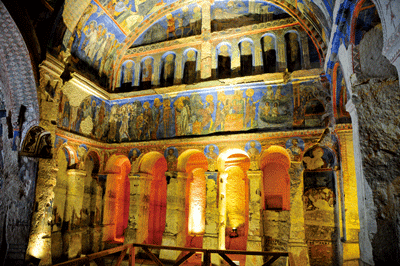
“The animals were also kept in the same rooms chiselled underground, and there were special tunnels for them to get in and out. You would not know or see the entrances to these tunnels. But humans were using ladders to get into the animals’ rooms. There were sheep, goats, poultry, cattle and their offspring…”
Thanks to Turkey’s untiring efforts in the field of archaeology and restoration, Xenophon’s reports have been proved true after decades of excavation revealing the labyrinthine hubs of Kaymakli, Derinkuyu, Sarath, Ozkonak, Tatlarin, Acigol and Mazi.
With villages existing above these underground settlements and hardly any tools or furniture to be found abandoned there, it is widely believed they provided only temporary security against invaders, especially the Arab armies that oppressed Christian communities.
A tourist to Cappadocia on limited time will usually be brought to see Kaymakli or Derinkuyu, but all the underground settlements mentioned share the same features: connections to the houses aboveground, paths and alleyways – substituting for the normal streets and avenues – spacious stables for animals on the first floor, large chimney structures used for air conditioning, ventilation and communication between homes, sitting rooms, kitchens and cafeterias, stone stoves and cavities to place oil lamps, water jugs and earthenware pots.
There were even hospitals, chapels, dining rooms, halls to house the dead before burying, toilets and septic wells.
To stymie the enemies, fake wells aboveground were devised to prevent them from poisoning the water. And to keep them from entering the tunnels, massive bolt stones weighing 200kg to 300kg and measuring 1m to 1.5m in diameter were used to seal tight the entrances.
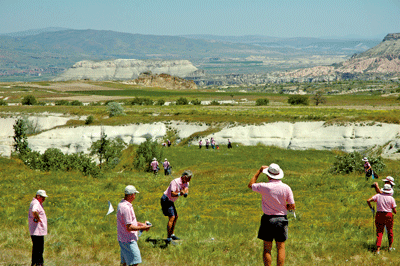
Kaymakli, which I visited, was a far cry from Vietnam’s claustrophobic Cu Chi Tunnels (the Vietcong’s clandestine stronghold, a two-hour drive from Ho Chi Minh City). Cu Chi’s mousehole of an entrance was enough to make my stomach want to heave up the morning’s breakfast. By contrast, the journey into Kaymakli’s cool depths was much more pleasant, aided by well-placed sconces, wider pathways and numerous but sturdy flights of steel staircases.
The city is said to have eight levels, but only four, reaching up to 20m below, can be explored at the moment. Anyway, after three, my thighs were on fire and I only made it to the final stage through sheer will power, being steered on by my patient guide Cihan (pronounced Ji-han) of Matiana Travel and the fact that a rambunctious group of Singaporeans behind us had brought their preternaturally cheerful 93-year-old grandmother along with them – and she didn’t look the worse for wear.
As the Lonely Planet guidebook aptly described the experience: “It’s like entering a very huge and complex Swiss cheese: holes here, holes there…” If not for the prominently displayed directional red arrows and bright wattage, it would be so easy to lose one’s way. Only after spending some time in Kaymakli does one realise that families could – and probably did – spend months on end entombed in that vast complex. Maps of various cities show several areas designated as wineries where grapes were crushed in the traditional way, by trampling on them. If people were going to be deprived of sunlight and freedom of movement a long time, at least they had the comfort of a good drink with their meals.
From the air, Cappadoccia proves just as fascinating.
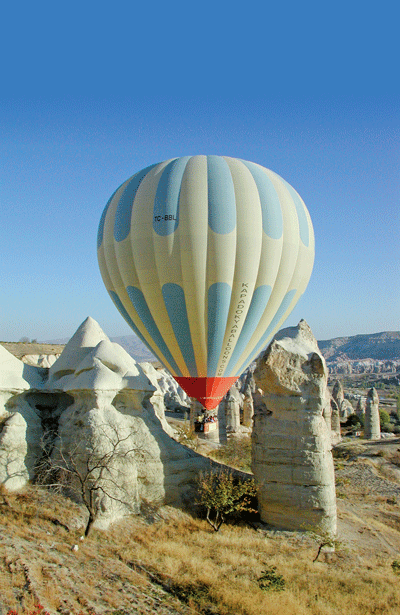
The eruption of three volcanoes, Erciyes Dagi, Hasan Dagi and Melendiz Dagi, millions of years ago spread lava and ash that eventually became a soft, porous stone known as tuff. Erosion and natural forces shaped the tuff into the famous “fairy chimneys” or peribaca, which are the pink- to russet-hued cones with boulders precariously perched on top that carpet entire valleys. Other Cappadocian landmarks, likewise created by volcanic activity, are the eerie moonscapes, vast gorges and picturesque plains dotted with fruit groves and vineyards.
And there is no better and quicker way to take in the entire panorama than to join a hot-air balloon ride.
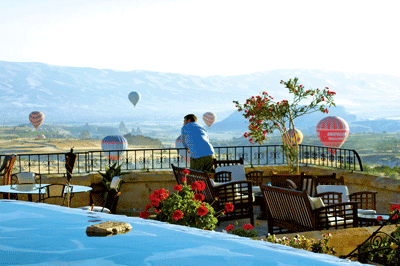
All right, so it means getting up at 4am or 4.30am (9am or 9.30am Hongkong time) to make the 4.45am pickup by Kappadokya Balloons, one of the area’s pioneers in the activity. But the exhilarating experience will guarantee you bragging rights with the folks back home, especially when you zap them amazing images of being among some 40 of these colourful envelopes drifting gracefully against a cerulean canvas. Not to worry – the precision and skill of the pilots ensure that there’s no possibility of a mid-air collision. Each man does try to show off how near they can come within “picking distance of apricots”, almost coming down to earth, indeed skimming orchards, but gently lifting off again before your wicker basket – containing you and 15 other fellow passengers – gets entangled in any nasty branches.
There are few adventures in the world worth waking up early for. A Cappadocian hot-air balloon ride definitely belongs to the realm of the unforgettable.
Hotel Check – Cappadocia
The Museum Hotel
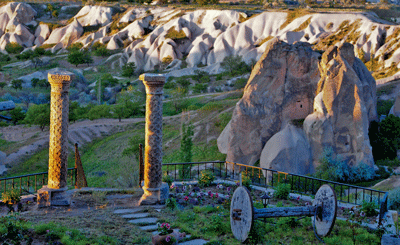
WHAT’S IT LIKE? This boutique hotel may carry the name “Museum”, but it’s far from being a stuffy, musty repository of civilisations gone by. Instead, owner and culture buff Omer Tosun has thoughtfully positioned priceless artifacts and handicrafts from his vast collection – covering the Seljuk, Ottoman, Roman and Hittite periods – in the guestrooms and public areas, creating the feel of a well lived-in mansion.
And thanks to a skilled team of architects and artisans, supervised by Tosun, the ruins of traditional cave homes have been transformed into a series of elegantly designed cocoons with grand views of the Cappadocia region.
WHERE IS IT? Located in Uchisar (meaning “castle on the edge” in Turkish and referring to an actual castle in the area), one of the highest points in Cappadocia. From either Nevsehir’s Kapadokya Airport or Kayseri’s Eriket Airport, it’s about one and a half hour’s drive to reach the hotel.
HOW MANY ROOMS? The hotel’s 30 rooms fall into six categories: Little Traditionals, Deluxe rooms, Deluxe suites, Junior Superior suites, Superior suites and Imperial suites. Due to the highly individual character of the establishment, each room is different from the rest, hence the absence of a regular online booking tool and the presence of a gallery of room images.
The management prefers that customers fill in the reservation form with their arrival dates, number of nights and people and other special requests. It will try to match the room with the needs of the guests or group.
ROOM HIGHLIGHTS The wonder of how an ancient cave home has been brought into the 21st century with hot and cold water and broadband internet access kept us captivated throughout our entire stay. Our Ebruli suite, furnished in the rich Ottoman style and boasting a small, overrun garden facing the valley, was reached by its own staircase, adding a sense of exclusivity.
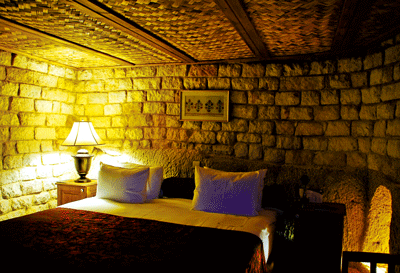
DINING Breakfast can be taken either indoors or poolside. The buffet is extensive, featuring a cooking station, a wide range of cheese and jams and Turkish staples such as deep-fried rolls with cheese fillings. Lil’a’s is a fine dining experience, helmed by award-winning Chef Buyukan, and offers Cappadocian specialties as well as other Turkish dishes with a twist. The chef is available for bookings for market tours and cooking classes. Many of the ingredients used in the hotel’s kitchens come from its own garden, situated nearby.
BUSINESS AND MEETINGS FACILITIES Wi-Fi is provided in the guestrooms as well as throughout the property. A spacious meeting room for 50 persons is available and the hotel will supply audio-visual equipment if required.
LEISURE FACILITIES Massage treatments can be arranged in the privacy of one’s guestroom or on the massage terrace. The infinity pool is shaped so that it accommodates lap exercises.
PRICE Rates start from €145 (US$182) for the standard-entry Little Traditionals category to €2,250 (US$2,826) for the Muhteshem Imperial suite.
CONTACT Tekelli Mah, 1 Uchisr, Nevsehir, tel 90384 219 2220, www.museum-hotel.com
Margie T Logarta
FAST FACTS
How to get there: Two international airports, Kayseri and the newer Nevsehir, serve Cappadocia. Turkish Airlines flies several times daily between Istanbul and these hubs. Journey time is about an hour and 20 minutes.
Where to stay: Do as the ancient Cappadocians did and stay in a cave home or its modern version, a cave hotel. There are too many to name in this fact box, but www.boutique-cave-hotelscappadocia.com is a good place to start. Or see our review of The Museum Hotel, the life’s work of Omer Tosun. The well-known carpet expert, who counts Prince Charles among his customers, bought several cave dwellings in Uchisar in 1995 and, with a team of artisans, painstakingly restored them to create an elegant bolthole that opened in 2003, overlooking a dramatic swathe of valleys and Mount Ercye. Unlike their former residents, today’s travellers will enjoy all mod cons, including high-speed broadband internet access.
Other sights and activities: ancient rock-hewn dwellings also used for protection against invaders; the Goreme Open-Air Museum, a cluster of rock-cut Byzantian churches, chapels and monasteries (above); cross golf, which aims to hit the ball into a net, not a hole; performances by whirling dervishes at the Saruhan caravanserai (roadside inn).








